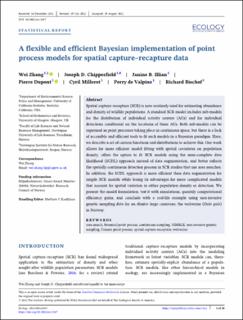| dc.contributor.author | Wei, Zhang | |
| dc.contributor.author | Chipperfield, Joseph | |
| dc.contributor.author | Illian, Janine | |
| dc.contributor.author | Dupont, Pierre | |
| dc.contributor.author | Milleret, Cyril Pierre | |
| dc.contributor.author | de Valpine, Perry | |
| dc.contributor.author | Bischof, Richard | |
| dc.date.accessioned | 2023-02-08T12:53:33Z | |
| dc.date.available | 2023-02-08T12:53:33Z | |
| dc.date.created | 2022-12-05T10:09:53Z | |
| dc.date.issued | 2022 | |
| dc.identifier.citation | Ecology. 2022, . | en_US |
| dc.identifier.issn | 0012-9658 | |
| dc.identifier.uri | https://hdl.handle.net/11250/3049305 | |
| dc.description.abstract | Spatial capture–recapture (SCR) is now routinely used for estimating abundance and density of wildlife populations. A standard SCR model includes sub-models for the distribution of individual activity centers (ACs) and for individual detections conditional on the locations of these ACs. Both sub-models can be expressed as point processes taking place in continuous space, but there is a lack of accessible and efficient tools to fit such models in a Bayesian paradigm. Here, we describe a set of custom functions and distributions to achieve this. Our work allows for more efficient model fitting with spatial covariates on population density, offers the option to fit SCR models using the semi-complete data likelihood (SCDL) approach instead of data augmentation, and better reflects the spatially continuous detection process in SCR studies that use area searches. In addition, the SCDL approach is more efficient than data augmentation for simple SCR models while losing its advantages for more complicated models that account for spatial variation in either population density or detection. We present the model formulation, test it with simulations, quantify computational efficiency gains, and conclude with a real-life example using non-invasive genetic sampling data for an elusive large carnivore, the wolverine (Gulo gulo) in Norway. area search, binomial point process, continuous sampling, NIMBLE, non-invasive genetic sampling, Poisson point process, spatial capture–recapture, wolverine | en_US |
| dc.language.iso | eng | en_US |
| dc.rights | Navngivelse 4.0 Internasjonal | * |
| dc.rights.uri | http://creativecommons.org/licenses/by/4.0/deed.no | * |
| dc.subject | area search | en_US |
| dc.subject | binomial point process | en_US |
| dc.subject | continuous sampling | en_US |
| dc.subject | NIMBLE | en_US |
| dc.subject | non-invasive genetic sampling | en_US |
| dc.subject | Poisson point process | en_US |
| dc.subject | spatial capture–recapture, wolverine | en_US |
| dc.title | A flexible and efficient Bayesian implementation of point process models for spatial capture‐recapture data | en_US |
| dc.title.alternative | A flexible and efficient Bayesian implementation of point process models for spatial capture‐recapture data | en_US |
| dc.type | Peer reviewed | en_US |
| dc.type | Journal article | en_US |
| dc.description.version | publishedVersion | en_US |
| dc.rights.holder | © 2022 The Authors | en_US |
| dc.subject.nsi | VDP::Økologi: 488 | en_US |
| dc.subject.nsi | VDP::Ecology: 488 | en_US |
| dc.source.pagenumber | 10 | en_US |
| dc.source.volume | 104 | en_US |
| dc.source.journal | Ecology | en_US |
| dc.identifier.doi | 10.1002/ecy.3887 | |
| dc.identifier.cristin | 2088525 | |
| dc.relation.project | Norges forskningsråd: 286886 | en_US |
| dc.source.articlenumber | e3887 | en_US |
| cristin.ispublished | true | |
| cristin.fulltext | original | |
| cristin.qualitycode | 2 | |

